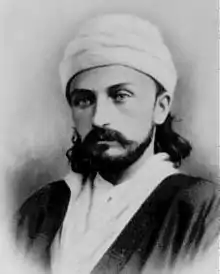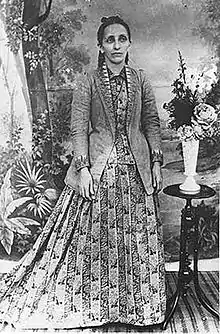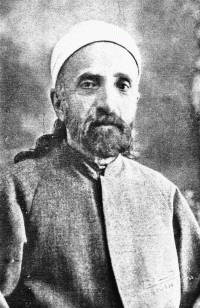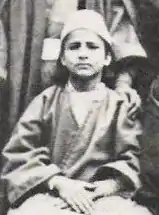Baháʼu'lláh's family
Baháʼu'lláh was the founder of the Baháʼí Faith.[1] He was born in 1817 to Khadíjih Khánum and Mírzá Buzurg of Nur (in the province of Mazandaran), a Persian nobleman, and went on to be a leader in the Bábí movement, and then established the Baháʼí Faith in 1863.[1][2] Baháʼu'lláh's family consists of his three wives and the children of those wives.
| Part of a series on |
| Baháʼí Faith |
|---|
 |
Titles of descendants
One of Baháʼu'lláh's titles is Sadratu'l-Muntahá, which translates from Arabic as the tree beyond which there is no passing (a quote from Qurʼan 53:14).[3][4] In this connection, Baháʼu'lláh entitled his descendants with terms relating to the Sadratu'l-Muntahá. His male descendants were given the title of Ag͟hsán (Arabic for "Branches") which in singular form is "G͟husn".[5] In particular, three of his sons were given specific "branch" titles:
- ʻAbdu'l-Bahá (given name, Abbás): G͟huṣn-i-Aʻẓam (Arabic: الغصن الأعظم "The Most Great Branch").[5]
- Mírzá Muhammad ʻAlí: G͟huṣn-i-Akbar, (Arabic: الغصن الأکبر "The Greater Branch").[5][6][7]
- Mírzá Mihdí: G͟huṣn-i-Athar, (Arabic: الغصن الأطهر "The Purest Branch").[5]
His daughters were given the title of Varaqat (translated from Arabic as "Leaves"). Thus Baháʼu'lláh's eldest daughter, Bahíyyih (given name, Fatimih), was given the title of the Greatest Holy Leaf.[8]
During Baháʼu'lláh's lifetime, he referred to his eldest son, Abbás, by terms such as "Sirru'lláh" (Mystery of God), or "Sarkár-i-Áqá" (the Master). After the death of Baháʼu'lláh, he chose the title "ʻAbdu'l-Bahá" (Servant of Bahá).[9] Baháʼu'lláh did not give his descendants any direct right to the property of others.[6][10] This contrasts with Shiʻa Islam in which sayyids were given special financial entitlements.
Ásíyih
Ásiyih was born in 1820 in the village Yalrud, Mazandaran.[2] Her father was Mirza Ismaʻil-i-Vazir, a powerful and wealthy Persian nobleman. Baháʼu'lláh addressed her as Navváb,[2] and the Most Exalted Leaf.[11] She was chosen to marry the young Baháʼu'lláh based on her rare physical beauty, wealth and piety.[12] The family had pre-existing roots with Baháʼu'lláh's family by virtue of their influence in the royal court which may have influenced the marriage arrangements. They married some time between 24 September and 22 October 1835 aged 15 in Tehran and she had seven of Baháʼu'lláh's children, of whom only three lived to adulthood.[13] She died in 1886 in ʻAkká,[2] and is buried on Mount Carmel within the vicinity of the Shrine of the Báb.[2] Baháʼu'lláh named her his "perpetual consort" and her son as his vicar.[2] Baháʼís regard the children of Ásíyih and Baháʼu'lláh to be the Baháʼí "holy family".[14] Her children were:
ʻAbbas Effendi

Better known as ʻAbdu'l-Bahá, ʻAbbas was born in 1844 and died in 1921. He was the oldest child of Ásíyih and Baháʼu'lláh.[15] He was variously referred to by Baháʼu'lláh as "Mystery of God", "The Master", "Perfect Exemplar" and "the Most Great Branch". After Baháʼu'lláh died on 29 May 1892, the Will and Testament of Baháʼu'lláh named ʻAbdu'l-Bahá as Centre of the Covenant, successor and interpreter of Baháʼu'lláh's writings.[9][15] During his time as head of the religion, while still a prisoner of the Ottoman Empire, he met with many pilgrims and was in constant communication with Baháʼís around the world.[16] After the 1908 Young Turks revolution freed all political prisoners in the Ottoman Empire, ʻAbdu'l-Bahá was freed from imprisonment and in 1910, with the freedom to leave the country, he embarked on a three-year journey to Egypt, Europe, and North America, spreading the Baháʼí message.[15][17] On 27 April 1920, he was awarded a knighthood by the British Mandate of Palestine for his humanitarian efforts during World War I.[15] ʻAbdu'l-Bahá died on 28 November 1921, and he is currently buried within one of the rooms at the Shrine of the Báb.
Bahíyyih

Bahíyyih Khánum was born in 1846 and was the eldest daughter of Baháʼu'lláh and Ásíyih Khánum.[18] She was entitled the Greatest holy Leaf.[8] She was particularly dear to her father and is seen within the Baháʼí Faith as one of the greatest women to have lived.[8] She stood by and remained faithful to the Centers of the Covenant over years of infighting within Baháʼu'lláh's family that led to the expelling of many of them.[8][18] She was given the position of acting head of the religion repeatedly when ʻAbdu'l-Bahá (during periods between 1910 and 1913), and Shoghi Effendi (during periods between 1922 and 1924), were absent from the Baháʼí World Centre in Haifa.[8][18][19] Shoghi Effendi in particular felt her support during a difficult period following the death of ʻAbdu'l-Bahá. She died on 15 July 1932 and was buried in the Baháʼí gardens downhill from the Baháʼí Arc on Mount Carmel, under the Monument of the Greatest Holy Leaf raised for her at the Baháʼí World Centre.[18]
Mírzá Mihdí

Mírzá Mihdí was born in Tehran in 1848 and was entitled the Purest Branch.[20] He died at the age of 22 on 23 June 1870 in ʻAkká after a fall through a skylight while he was preoccupied in prayer.[20] The death is significant as Baháʼís believe that Baháʼu'lláh offered him the chance of being cured. However, he chose to use his life as a sacrifice so that the close imprisonment of the Baháʼís would end.[20] Mírzá Mihdí was eventually buried alongside his mother in the gardens below the Baháʼí Arc on Mount Carmel in Haifa near his brother and sister.[20]
Others
Ásíyih bore at least four other children all sons,[21] but due to their early deaths little is known about them:
Fatimih
Fatimih was born in 1828 in Mazandaran and was generally known as Mahd-i-'Ulya.[13] A first cousin of Baháʼu'lláh, Fatimih was married at fourteen to an influential cleric several decades older than she was. She seems to have been widowed shortly afterwards, perhaps aged sixteen.[23] It is reported that Baháʼu'lláh's aunt implored him to wed his widowed cousin and he reluctantly agreed to do so.[23] They married in 1849 in Tehran and she had six of Baháʼu'lláh's children, of whom four survived to adulthood.[13] She was said to have been very jealous of and harboured great enmity towards ʻAbdu'l-Bahá.[24] She died in 1904, and was later labelled a Covenant-breaker.[25]
Her children are:
Samadiyyih
Samadiyyih married Majdu'd-Din, who was the son of Aqay-i-Kalim, Baháʼu'lláh's brother;[26][27] Majdu'd-Din was one of ʻAbdu'l-Bahá's greatest critics, and Samadiyyih and Majdu'd-Din were eventually declared Covenant-breakers. She died at age 49 in 1904/5 and her husband died at over one-hundred years of age in 1955.[26][27]
Muhammad-ʻAlí

Mírzá Muhammad ʻAlí was born in Baghdad in 1853.[28] Baháʼu'lláh called him the "Greater Branch" and when Baháʼu'lláh declared ʻAbdu'l-Bahá his successor, he set that Muhammad ʻAlí was next in rank after him.[28][29] Motivated by jealousy of ʻAbdu'l-Bahá he conspired to undermine his brother's leadership, but he was unable to gain extensive support from the Baháʼís.[28] When ʻAbdu'l-Bahá died, his will went into great detail about how Muhammad ʻAlí had been unfaithful to the Covenant, labelling him a Covenant-breaker, and appointing Shoghi Effendi his successor instead.[30][31] Muhammad ʻAlí was described by Shoghi Effendi as the "Arch-Breaker of Baháʼu'lláh's Covenant".[28][32] Muhammad ʻAlí died in 1937.[28]
Ḍíyáʼu'lláh

Ḍíyáʼu'lláh (alternate spelling: Zíyá'u'lláh) was born August 15, 1864 in Edirne (modern day Adrianople).[2][33] He swayed between the two sides in his brothers' argument, and died before taking part in an act against ʻAbdu'l-Bahá, but has still been labelled a Covenant-breaker.[34] He died on October 30, 1898.[35] He married Thurayyá Samandarí, daughter of Shaykh Kázim-i-Samandar. The marriage was childless, and according to Samandar's memoirs, Mírzá Muhammad ʻAlí had prevented her from returning to him. After his death in 1898, Ḍíyáʼu'lláh was initially buried next to his father at the Shrine of Baháʼu'lláh at the Mansion of Bahjí. However, having been declared a Covenant-breaker, Ḍíyáʼu'lláh's remains were disinterred in a "process" of "purification" through "cleansing" the "inner sanctuary" of the "most hallowed shrine," the "Qiblih" of the "Baháʼí World" at the request of relatives opposed to the Covenant-breaker faction of the family.[36]
Mirza Badiʻu'llah Effendí
.jpg.webp)
Mirza Badiʻu'llah Effendí was born in Adrianople in 1867.[2] For much of his life he supported his brother's challenge to ʻAbdu'l-Bahá's authority as Centre of the Covenant. However, in 1903 Badiʻu'llah rejected Muhammad-ʻAlí, and delivered his loyalty to ʻAbdu'l-Bahá and circulated an open letter denouncing Muhammad-ʻAlí, known as Badiʻu'lláh's epistle;[4][37] however his loyalty to ʻAbdu'l-Bahá was short lived. He died in Israel on November 1, 1950.[2]
Gawhar

Gawhar was born in Kashan to a Bábí family of the city. She was brought to Baghdad by her brother Mirza Mihdiy-i-Kashani with his intention reportedly being for her to serve the household and Ásíyih Khánum.[38] Baháʼu'lláh married her some time around 1862.[13] When Baháʼu'lláh left Baghdad in 1863, unlike the other two wives, Gawhar remained in Baghdad.[13] During her time in Baghdad she stayed and lived with her brother.[26] Shortly afterwards, the Baháʼí community of Baghdad was rounded up and exiled to Mosul, and Gawhar with her brother were some of the exiles.[26] Her brother wrote a number of times asking Baháʼu'lláh to allow them to enter Akká and finally he accepted. Brother and sister arrived in late 1870.[39] Gawhar may have been a maid of the first wife of Baháʼu'lláh when he married her.[40] Baháʼu'lláh and Gawhar had one daughter, Furúghíyyih who was born in ʻAkká. Both mother and daughter were declared Covenant-breakers after the death of Baháʼu'lláh.[26] Gawhar died sometime between 1892 and 1921.
Furughiyyih
Relatively little is known about Furughiyyih. Furughiyyih was the daughter of Baháʼu'lláh and she was married to Siyyid Ali Afnan, the son of the Báb's brother-in-law.[34] She, her husband and her children (in particular her eldest Nayyir), all sided with Muhammad-ʻAli, and were labelled Covenant-breakers.[26] She bore four children:
- Late Hussain Effendi Afnan
- Nayyar Effendi Afnan
- Feyzi Effendi Afnan
- Hassan Effendi Afnan[41]
Plurality of wives
Baháʼu'lláh had three concurrent wives,[13][44] when his religion teaches monogamy, and this has been the subject of criticism. Baháʼí teachings on gender equality and monogamy post-date Baháʼu'lláh's marriages and are understood to be evolutionary in nature, slowly leading Baháʼís away from what had been a deeply rooted cultural practice.[44]
Baháʼu'lláh married his first wife in Tehran when they both were Muslims, and he married his second wife also in Tehran, when he, his first wife, and his new wife were all Bábís and no longer Muslims.[13] According to the laws and tradition of Islam, which Baháʼu'lláh would have been following at the time of his marriages, a man is allowed four wives.[44][45] Baháʼí marriage laws were written in the Kitáb-i-Aqdas more than ten years after his last marriage. In that book he limits the number of wives to two with no concubines and states that having only one wife would be the cause of tranquility for both partners.[44][46] This was later interpreted by ʻAbdu'l-Bahá that having a second wife is conditional upon treating both wives with justice and equality, and was not possible in practice, thus establishing monogamy.[44][47][48] This interpretation is probably influenced by the equivalent reasoning of some Muslim scholars who interpret the Quran's permissive stance on polygamy - restricted to 4 wives - as indicated in verse 4:3 to be subject of the impossible condition of absolute justice on part of the husband.
Baháʼí apologia
The general view among Baháʼu'lláh's family and Baháʼís today is that all the wives were legal and equal. The question about how this conforms to religious law is addressed directly in two letters from Universal House of Justice quoting Shoghi Effendi twice:
- "Baháʼu'lláh had no concubine. He had three legal wives. As He married them before the "Aqdas" (His book of laws) was revealed, he was only acting according to the laws of Islám, which had not yet been superseded. He made plurality of wives conditional upon justice; ʻAbdu'l-Bahá interpreted this to mean that a man may not have more than one wife at a time, as it is impossible to be just to two or more women in marriage."
- "...Baháʼu'lláh married the first and second wives while he was still in Tihrán, and the third wife while he was in Baghdád. At that time, the Laws of the "Aqdas" had not been revealed, and secondly, he was following the Laws of the previous Dispensation and the customs of the people of his own land.".[49]
Baháʼís argue that polygamy is an ancient practice and other religions did not require monogamy.[50] Under the Law of Moses a man could take as many wives as he chose.[51] Most Christian groups have historically not practiced and condemned polygamy; some, however, have advocated it. In the Arabian peninsula Muhammad introduced a limit of four wives; polygamy was unlimited in pre-Islamic Arabia.[52][53] The Baháʼí Faith slowly introduced monogamy to a region that considered polygamy a righteous lifestyle.[44] Note 89 of the Kitáb-i-Aqdas comments on the verse in question:
- "Baháʼu'lláh, who was revealing his teachings in the milieu of a Muslim society, introduced the question of monogamy gradually in accordance with the principles of wisdom and the progressive unfoldment of his purpose. The fact that he left his followers with an infallible interpreter of his writings enabled him to outwardly permit two wives in the Kitáb-i-Aqdas but uphold a condition that enabled ʻAbdu'l-Bahá to elucidate later that the intention of the law was to enforce monogamy."[54]
Notes
- Smith 2000, p. 73
- Smith 2000, pp. 261–262
- Buck 1995, pp. 4–5
- Scharbrodt 2008, pp. 86–87
- Smith 2000, p. 30
- Smith 2008, p. 43
- G͟husn-i-Aʻẓam and G͟husn-i-Akbar can both be translated as "the great branch", "the greater branch" or "the most great branch". Aʻẓam carries a higher status in Arabic (see Baalbaki 2005, or Steingass 2005), so Baháʼí authors and others translate ʻAbdu'l-Bahá's title as "Most Great" and Muhammad ʻAlí's title as "Greater" (Taherzadeh, 2000, p. 256.). The designations of G͟husn-i-Aʻẓam and G͟husn-i-Akbar are clear. (Browne, 1918, p. 61, & p. 85 )
- Bramson 2004, pp. 102–103
- Momen 2004, pp. 97–98
- Baháʼu'lláh 1994, p. 222
- Ma'ani 2008, p. 85
- Ma'ani 2008, p. 84
- Smith 2008, p. 16
- Ma'ani 2008, p. 87
- Bausani, Alessandro (1989). "ʻAbd-al-Bahāʼ : Life and work". Encyclopædia Iranica.
- Balyuzi 2001, p. 69
- Balyuzi 2001, pp. 159–397
- Smith 2000, pp. 86–87
- Khan 2005, pp. 78, 79, 84, 131
- Smith 2000, pp. 246–247
- Browne 1918, pp. 320–321
- Ma'ani 2008, p. 90
- Ma'ani 2008, pp. 230–2
- Taherzadeh 1992, p. 136
- Taherzadeh 2000, p. 117
- Taherzadeh 2000, p. 25
- Taherzadeh 2000, p. 144
- Smith 2000, p. 252
- Smith 2008, p. 46
- Smith 2008, p. 45
- ʻAbdu'l-Bahá 1921, p. 5
- Effendi 1944, p. 263
- Balyuzi 2001, pp. 222
- Taherzadeh 2000, p. 145
- Balyuzi 2001, p. 528
- Marks, Geoffry W., ed. (1996). Messages from the Universal House of Justice 1963-86: The Third Epoch of the Formative Age. Baha'i Publishing Trust. p. 66. ISBN 978-0877432395.
- Hollinger 1984, pp. 118–119
- Ma'ani 2008, p. 252
- Ma'ani 2008, p. 253
- Cole, Juan. "A Brief Biography of Baháʼu'lláh". Archived from the original on 9 September 2006. Retrieved 2006-09-27.
- Sohrab, Ahmad (1943). Abdul Baha's Grandson Story of a Twentieth Century Excommunication. Universal Publishing Company, New York. p. 24.
- Taherzadeh 1992, p. 251
- Behai, Shua Ullah (December 5, 2014). Stetson, Eric (ed.). A Lost History of the Baha'i Faith: The Progressive Tradition of Baha'u'llah's Forgotten Family. Vox Humri Media. pp. 228–229. ISBN 978-0692331354.
- Smith 2000, pp. 273–274
- Saiedi 2008, pp. 307–308
- Baháʼu'lláh 1873, p. para. 63
- Smith 2008, p. 205
- Baháʼu'lláh 1873, pp. 205–206
- Letter from Universal House of Justice: 1998, April 06, Memorandum re Wives of Baháʼu'lláh
- Universal House of Justice, (1996), p. 449, and Letters from Universal House of Justice, October 23, 1995, June 27, 1996, and April 06, 1998.
- Alexander McCaul (1837). The old paths; or, A comparison of the principles and doctrines of modern Judaism with the religion of Moses and the prophets. London Society's Office. pp. 186.
- Khadduri, Majid (Spring 1978). "Marriage in Islamic Law: The Modernist viewpoints". The American Journal of Comparative Law. American Society of Comparative Law. 26 (2): 213–218. doi:10.2307/839669. JSTOR 839669.
- Cleveland, William L. (2004). A History of the Modern Middle East. Westview Press. p. 30. ISBN 0-8133-4048-9.
- Synopsis and Codification... of the Kitab-i-Aqdas, note 89
References
- ʻAbdu'l-Bahá (1921). The Will And Testament of ʻAbdu'l-Bahá. Mona Vale, N.S.W, Australia: Baháʼí Publications Australia (published 1992). ISBN 0-909991-47-2.
- Baalbaki, Rohi (2005). AL Mawrid Al Quarib (Arabic English Dictionary) (9th ed.). Beirut, Lebanon: Dar el-Ilm lil-Malayēn. ISBN 1-894412-94-X.
- Baháʼu'lláh (1873–92). Tablets of Baháʼu'lláh Revealed After the Kitáb-i-Aqdas. Wilmette, Illinois, USA: Baháʼí Publishing Trust (published 1994). ISBN 0-87743-174-4.
- Ma'ani, Baharieh Rouhani (2008). Leaves of the Twin Divine Trees. Oxford, UK: George Ronald. ISBN 0-85398-533-2.
- Baháʼu'lláh (1873). The Kitáb-i-Aqdas: The Most Holy Book (published 1992).
- Balyuzi, H.M. (2001). ʻAbdu'l-Bahá: The Centre of the Covenant of Baháʼu'lláh (Paperback ed.). Oxford, UK: George Ronald. ISBN 0-85398-043-8.
- Bramson, Loni (2004). "Bahiyyih Khanum (sic)". In Jestice, Phyllis G. (ed.). Holy People of the World: A Cross-cultural Encyclopedia. Santa Barbara, CA: ABC-CLIO. ISBN 1-57607-355-6.
- Browne, E.G. (1918). Materials for the Study of the Bábí Religion. Cambridge: University Press.
- Buck, Christopher (1995). Symbol and secret: Qurʼan commentary in Baháʼu'lláh's Kitáb-i íqán. Los Angeles: Kalimát Press. ISBN 0-933770-80-4.
- Cole, Juan. "A Brief Biography of Baháʼu'lláh". Archived from the original on 9 September 2006. Retrieved 2006-09-27.
- Effendi, Shoghi (1944). God Passes By. Wilmette, Illinois, USA: Baháʼí Publishing Trust. ISBN 0-87743-020-9.
- Hollinger, Richard (1984). "Ibrahim George Kheiralla and the Baha'i Faith in America". In Smith, Peter; Cole, Juan R.; Momen, Moojan (eds.). From Iran East and West. Kalimat Press. ISBN 0-933770-40-5.
- Khan, Janet A. (2005). Prophet's Daughter: The Life and Legacy of Bahíyyih Khánum, Outstanding Heroine Of The Baháʼí Faith. Wilmette, Illinois, USA: Baháʼí Publishing Trust. ISBN 1-931847-14-2.
- Marks, Geoffry W., ed. (1996). Messages from the Universal House of Justice 1963-86: The Third Epoch of the Formative Age. Baha'i Publishing Trust. ISBN 978-0877432395.
- Momen, Moojan (2004). "Baha'i Faith and Holy People". In Jestice, Phyllis G. (ed.). Holy People of the World: A Cross-cultural Encyclopedia. Santa Barbara, CA: ABC-CLIO. ISBN 1-57607-355-6.
- Taherzadeh, Adib (1992). The Covenant of Baháʼu'lláh. Oxford, UK: George Ronald. ISBN 0-85398-344-5.
- Taherzadeh, Adib (2000). The Child of the Covenant. Oxford, UK: George Ronald. ISBN 0-85398-439-5.
- Saiedi, Nader (2008). Gate of the Heart. Waterloo, ON: Wilfrid Laurier University Press. ISBN 978-1-55458-035-4.
- Scharbrodt, Oliver (2008). "Succession and renewal". Islam and the Baha'i Faith: A Comparative Study of Muhammad Abduh and Abdul-Baha Abbas. Routledge. ISBN 0-415-77441-1.
- Smith, Peter (2000). A concise encyclopedia of the Baháʼí Faith. Oxford: Oneworld Publications. ISBN 1-85168-184-1.
- Smith, Peter (2008). An Introduction to the Baha'i Faith. Cambridge: Cambridge University Press. ISBN 0-521-86251-5.
- Steingass, F.J. (1892). A Comprehensive Persian-English Dictionary, Including the Arabic words and phrases to be met with in literature. New Delhi, India: Munshiram Manoharlal Publishers Pvt. Ltd., New Delhi (published 2005). ISBN 81-7304-669-7.
Further reading
- Research Department at the Baháʼí World Centre, ed. (1982), Bahíyyih Khánum, the Greatest Holy Leaf: A Compilation from Baháʼí Sacred Texts and Writings of the Guardian of the Faith and Bahíyyih Khánum's Own Letters, Haifa, Israel: Baháʼí World Centre, ISBN 0-85398-131-0
- Momen, Moojan Cyprus Exiles, The: in Baháʼí Studies Bulletin, 5:3-6:1, pp. 84–113. 1991-06.
- Munírih Khánum. Munírih Khánum - Memoirs and Letters. Sammireh Anwar Smith (trans.). Los Angeles, United States: Kalimát Press.
- National Spiritual Assembly of the Baháʼís of the United States (ed.) (1976) [1943]. Baháʼí World Faith: Selected Writings of Báha'u'lláh and Abdu'l-Bahá. Wilmette, Illinois, USA: Baháʼí Publishing Trust. ISBN 0-87743-043-8.CS1 maint: extra text: authors list (link)
- Nabíl-i-Zarandí (1932). The Dawn-Breakers: Nabíl's Narrative. Translated by Shoghi Effendi (Hardcover ed.). Wilmette, Illinois, USA: Baháʼí Publishing Trust. ISBN 0-900125-22-5.
- Behai, Shua Ullah (December 5, 2014). Stetson, Eric (ed.). A Lost History of the Baha'i Faith: The Progressive Tradition of Baha'u'llah's Forgotten Family. Vox Humri Media. ISBN 978-0692331354.
- Universal House of Justice (1996). Marks, Geoffry W. (ed.). Messages from the Universal House of Justice, 1963-1986: The Third Epoch of the Formative Age. Wilmette, Illinois, USA: Baháʼí Publishing Trust. ISBN 0-87743-239-2.
- Universal House of Justice (27-06-1996). Letter on Monogamy, Sexual Equality, Marital Equality, and the Supreme Tribunal.
- Universal House of Justice (23-10-1995).Letter from Universal House of Justice about the wives of Baháʼu'lláh
External links
| Wikimedia Commons has media related to Family of Bahá'u'lláh. |
- Badiʻu'llah's epistle
- Mírzá Mihdí - The Purest Branch (archived)
- Mírzá Musa - Aqay-i-Kalim (archived)
- Navvab - Asiyih Khanum (archived)
- Mirza Husayn ʻAli - Baháʼu'lláh (archived)